Description
The Aquatic Productivity Bottles rest in a rack that provides consistent and reliable light control for quantitative aquatic productivity studies. Students fill the bottles with algae solution or pond water and then they measure the dissolved oxygen concentration in the solutions before and after incubation in fluorescent light. By comparing the dissolved oxygen concentrations in each solution, students learn about the relationship between light intensity, dissolved oxygen concentration, photosynthetic activity, and the primary productivity of aquatic ecosystems.
- The identical transparent bottles nest in each of five rack positions.
- The custom design of the rack shields the bottles from light by blocking a fixed percentage of light in 25% increments from zero to 100%.
- This apparatus ends the frustration and uncontrollable mess involved with using screens and tape or rubber bands to block light.
What’s Included
- 5x Plastic bottles w/lids
- 1x Case with slotted lid
Typical Applications
By comparing the dissolved oxygen concentrations in each solution, students learn about the relationship between light intensity, dissolved oxygen concentration, photosynthetic activity, and the primary productivity of aquatic ecosystems.
Experiment Description
Fill Aquatic Productivity Bottles with algae solution, and measure the initial dissolved oxygen (DO) concentrations of the solutions using the DO sensor. Place bottles into the cradle of the apparatus and close the incremental light-blocking lid over the bottles. Incubate for 24 hours in fluorescent light. Remove bottles from the cradle and measure DO concentration using the DO sensor. Compare the initial and final dissolved oxygen concentration to calculate Net Primary Productivity and Gross Primary Productivity.

Net Primary Productivity (mg/L) vs. Light Intensity (%)



